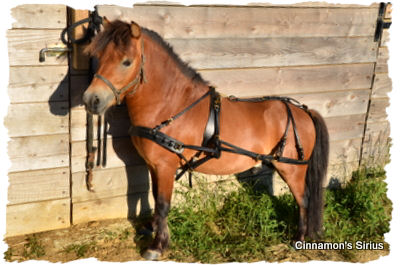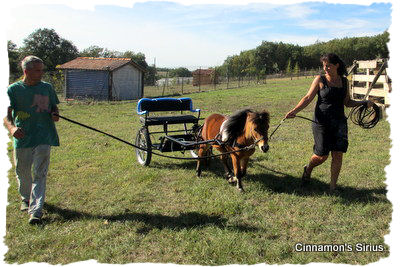![]()
Driving the Miniature Horse
Driving is certainly becoming the most popular activity with the Miniature Horse, wether it is to compete in the show ring, in working classes like Combined Driving Events, or the enjoyment of pleasure driving in the countryside.
Under ideal conditions, the miniature horse is able to pull twice his weight - approximately 200 kg, depending on his size . To achieve maximum performance, driving will need a ground not too heavy and deep and not too hilly but above all the horse needs to have the appropriate conformation.
Conformation requirements for driving
The smaller and more frail the Miniature Horse is, the less power and strength he will have to pull the cart and the faster the maximum of twice its weight will be reached. Some size and a horse a bit "heavier boned" is beneficial. The legs should be straight and free of any physical defects for proper gaits. Conformation and quality of movement are closely related! A shoulder angle that's too upright wouldn't allow expansive gaits, a short and thick neck will prevent the horse to flex properly. The way the horse carries his neck and head is important for his ability to pull.
It is desired that the horse carries his neck high. The hip should be well-muscled to allow proper propulsion and a collected fashion. The gait of most interest is the trot. The movement should be space-covering with the horse lifting his knees and hocks. Ideally the horse will reach out in front of himself with his front legs, and the hind feet will land in the tracks that the front feet left, or even a bit in front of them. The top of the horse's back should show a smooth and leveled movement. Every bounce will transfer directly to the cart and make the drive uneasy.
The character of the driving horse is also of great importance. Education and training can compensate most of lacks, but it makes things much easier when the horse has an adequate and balanced character. He should be respectful, voluntary, not too hot-tempered and not fearfull .
The gender of the driving horse can be important too. Sallion are very resistant to effort, they look proud and very showy, but they can be more difficult to train and will need more rigorous education. They have to be absolutely respectfull and have very good manners, to be under control even in company of other horses. They are not allowed to challenge other males or to show off in front of mares. Mares will be easier to handle, but they can moody and irritable when they're in season. A gelding with a great caracter will be a safe choice as a driving propsect: easy to train and always equal to himmself ... year round
Training of the driving horse
Before training a Miniature Horse to drive, it is necessary that he has acquired some basics of classical dressage. The horse must be respectful to the human while being confident, obedient, not spooky. He should perfectly know the lunge line training, hold the gait we ask for and stop when we ask for. Next step is long rein training. The horse learns to go ahead without a leader to his side, he learns direction and to respond to the bit, achieves some perfection in responding to "whoa" as long as we ask for. Desensitization should be part of the training, to make sure the horse is not spooky in front of unfamiliar situations (dealing with scary objects, noise, barking dogs...). He should also be desensitize to the contact of ropes and rigid things against his body, between his legs, under his belly and under the tail. We don't want him to be frightened when he'll feel the contact of shafts and traces close to his body. We must anticipate unexpected situations, which can turn into a tragedy if the horse panics , eg if he passes a leg over a trace. It is in these moments that we will be glad having taken the time to fully educate and desensitize the horse.
Breaking to drive
Because of the need of prior basic education and dressage, driving training will nort be started before the horse's age of three years. A pre-driving-training can be started from the age of 2 years, but personally I prefer to wait until the horse has at least 3 years before he actually pulls weight and before hitching him to a cart. It is a question not only of skeletal maturity, but also mental maturity of the horse.The strict breaking to drive of the Miniature Horse can be left to a professional, but you can also do it yourself with a good dose of common sense, patience, and safe and appropriate structures. Several methods coexist and each is certainly valid, has its advantages and disadvantages. Here is a photo-description of the one I have choosen.
First contact with the harness |
Fitting the harness while moving 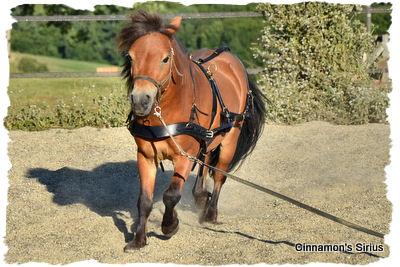 |
Long rein training in harness 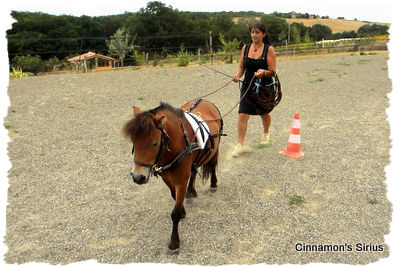 |
During the harness fittings and exercises without the horse being hitched to the cart, ensure that no unused straps hang down, so that the horse does not walk on them and does not get his feet caught in the straps. All exercises are done in a safe place, here in an arena. |
First contact and desensitization with a single shaft , tinkered with a PVC tube. The tube is attached to the surcingle girth in a way that it can be detached quickly in case of panic. The first trials are made in hand, then at the lunge line. Do not forget to do the exercises with the tube on both sides and exercises at both hands. |
|
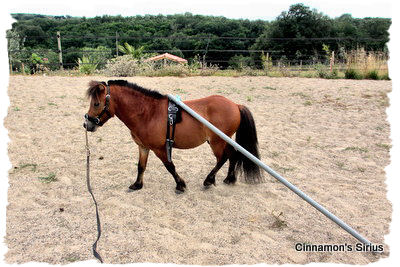 |
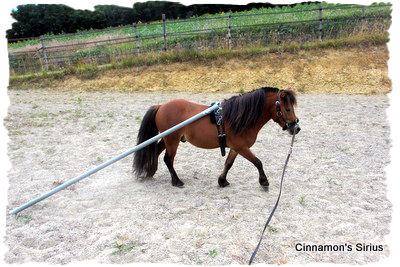 |
Same exercice with PVC tube-travois 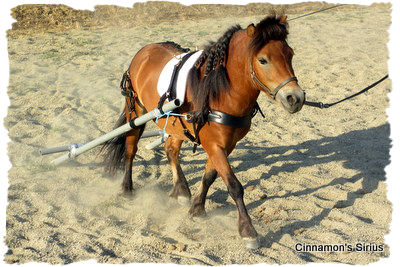 |
This construction is rigid and "traps" the horse... a completely new sensation!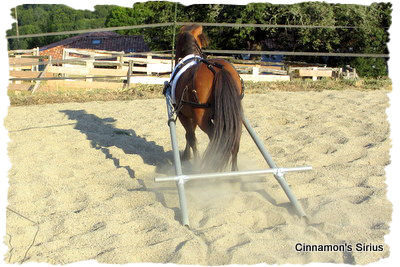 |
Once the horse is feeling confident about the travois, real weight to pull is added: a car tire .That's a bit heavier and has a higher resistance , also causes some noise 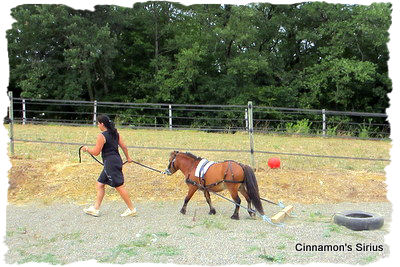 |
And also the traces are not reigid like the PVC tubes, they stretch and relax after each traction. Another new sensation for the horse... 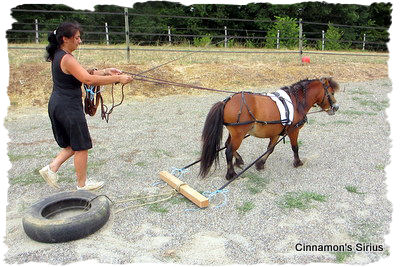 |
| The next step is the contact of the horse with the cart. I did not photograph this step, but I start the horse walking beside the cart pulled by a person. Then I positioned the horse between the shafts , without attaching the traces without sliding the shafts into the loops. | |
The first time the horse is hitched, it takes only a few minutes: just the time to fix all the straps and undo everything before the horse can start moving, or be afraid and make a bad experience. Next time we'll walk a few steps ;-) 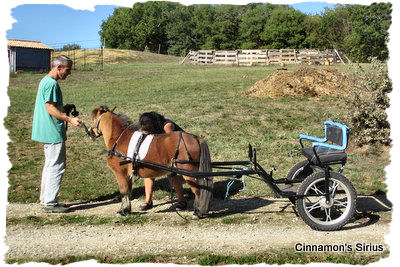 |
The horse pulls the cart, hold and framed by two persons. Our training is good, everything goes great! |
| First rides are done with the horse discretly hold on the lead rope for more security. Then the horse is not hold anymore, but the aid stays close to the horse to help if necessary. And gradually we became independent in the arena and in our fully enclosed property. The first outside rides are made again accompanied by a person ready to help if needed. | |
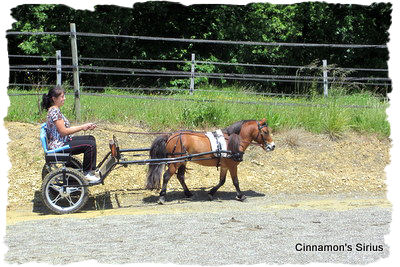 |
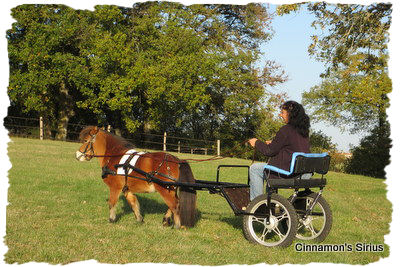 |
The right equipment for driving
The driving harness :
It is obviously necessary to use equipment adapted to the size of the Miniature Horse. For reasons of safety and comfort of the horse is out of the question to tinker or get along with inadequate equipment! Harness for Shetland ponies are still too big, especially too wide for a Miniature Horse. It is the same for Harness for Mini Shetland.
It is possible to have a custom made harness by a saddler of trust, but there are also good equipment in specialized saddleries. For example:
My favorite is the "carriage harness" avec" v-brest collar" sold by Ozark: http://www.minitack.com/mw135.htm It's made of smooth leather of great quality, and it fits perfectly to a Miniature Horse. It looks nice for a reasonable price.
For those who don't look at the price, the best is certainly the Comfi Fit Harness: http://www.comfyfitharness.com/index.html The price is of any other class, but you can freely compose the harness according to preferences. There is a wide choice regarding color, material, with or without padding, with classical or anatomic brest-collar or with french collar, etc ...
Bridle, bit and reins ... what to choose?
The choice is large and depends on your preferences, but also on the horse. I personally assume that the simplest and mildest is the best choice, as I do not have special needs. If the horse is perfectly obedient, easy to control and has a sensitive and responsive mouth, a single or double jointed snaffle bit, eg an eggbutt snaffle will allow you to communicate clearly with your horse. According to the temperament of the horse, a more severe bit can be necessary.
Most horses are trained to drive with blinders, so they can't see what is comming from behind them, and that is supposed to give more safety for the driving outside. I personnally prefer driving my horse with an open bridle without blinders, so that he can see and become comfortable with what happens around him. However he can hear what happens, so why shouldn't he see it? The drawback is that without blinders, the horse is more easily distracted by his entourrage , but so far it has not caused me any real problems.
Side- and/or over-check can be required in some shows. For these occasions it is advisable to have previously trained the horseto deal with them. The checks are used to lift the neck and head position of the horse to make him work better, therefore their use should only be temporary for the purpose of training. The martingale is also used to control the headposition, but in the other direction: it limits the elevation of the head and is used for a horse too agitated or rearing. Personally I'm still a fan of keeping it simple as first choice : I do not use check reins or martingale for driving.
The driving cart
As for the rest , the cart must be adapted to the size of the Miniature Horse, while being safe and solid quality. Clemobil offers a two-wheel cart (GIG) of French manufacturing and top quality , Super Mini Junior, but the weight is a little high:
the model with suspensionhas a weight about 50 kg without the shafts. It is the cart that you can see on the pictures of the breaking to drive. I am satisfied with the quality of materials, the robustness of the cart off-road, but I would have appreciated the cart a little lighter. However, can a lower weight offer the same durability and strength ...?
Another cart I have not personally tried, but many users seem satisfied of it, is the voiture d'attelage Shetland sold by Equiphorse. It is lighter than the model by Clemobil and materials do not inspire me so much confidence. But not having used it myself, I can't say anything reliable. Users of this cart say it is OK and resists for use on country roads.
The sulky.nl website sells small carts for ponies and Miniature Horses: the Pirouette and Cavalettie models seem to fit the size of a Miniature Horse. For accurate information , it is best to ask directly the seller or french dealer AJ Cheval
Pleasure of driving ... some photos of a driving contest and a video of driving in the countryside
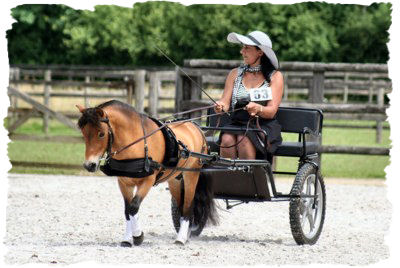 |
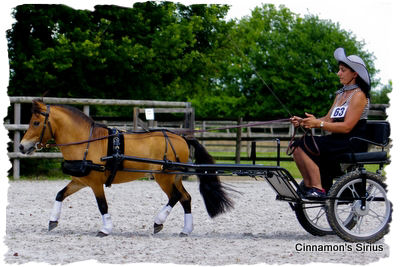 |
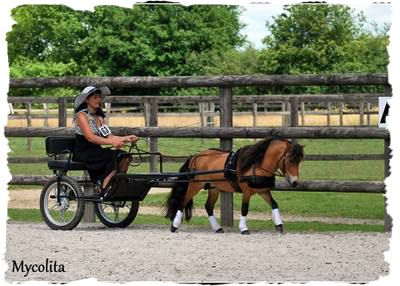 |
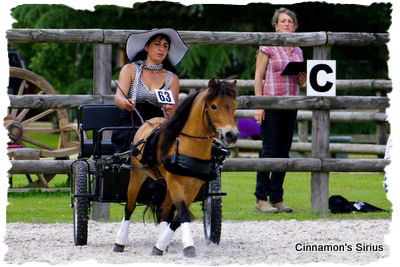 |
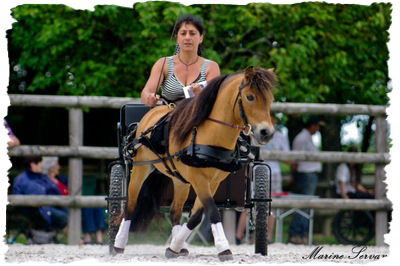 |
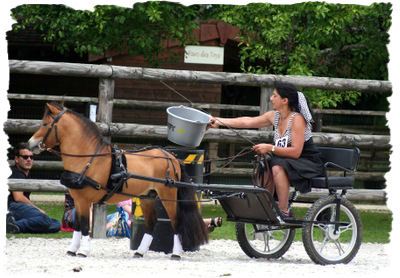 |
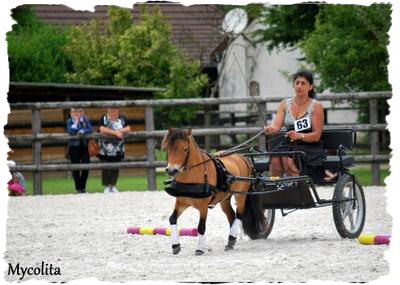 |
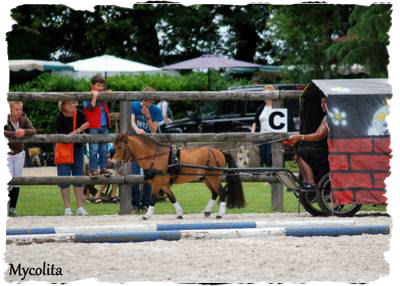 |


